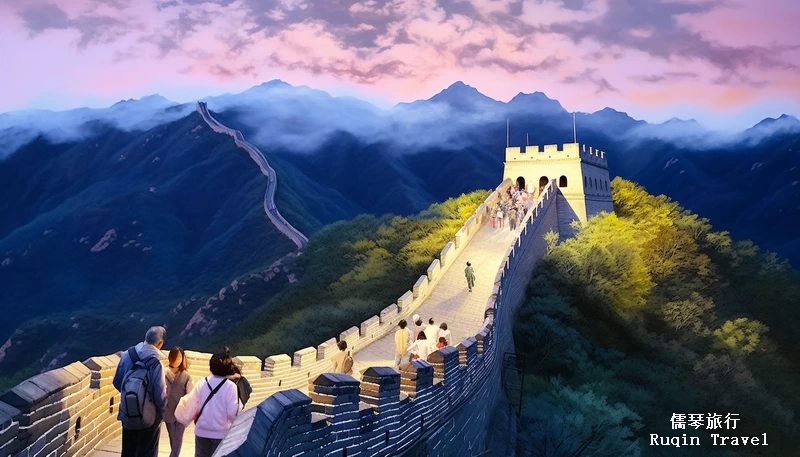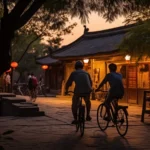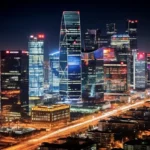Beijing, a city that seamlessly blends ancient history with modern marvels, transforms into a photographer’s paradise at night.
As the sun sets, the city’s landmarks and hidden gems alike are bathed in a magical glow, offering an array of stunning photographic opportunities.
This guide, tailored for night photography enthusiasts and first-time visitors, will unveil the 10 best spots for night photography in Beijing. Prepare to capture the essence of Beijing’s nocturnal beauty, where every click tells a story of cultural richness and contemporary vibrancy.
1. Jingshan Park and The Forbidden City
Jingshan Park offers a remarkable vantage point for capturing the Forbidden City under the sunset or the moonlight. Although entry to the Forbidden City is restricted at night, the illuminated ancient walls and gates create a mesmerizing contrast against the night sky.
The view from Jingshan Park, with its elevated position, provides a panoramic backdrop, perfect for wide-angle shots. To reach this spot, take the subway to Tiananmen West and enjoy a short walk to the park. Jingshan itself, with its lush gardens and historical significance, also presents numerous photo opportunities, especially during sunset.
To reach Jingshan Park, which offers an exceptional view for photographing the Forbidden City at night, follow these directions:
- Subway: The most convenient way to get to Jingshan Park is by Beijing’s subway system. Take Line 1 or Line 2 and get off at the Tiananmen West Station. From there, it’s a short walk north to the park.
- Bus: Numerous bus routes service the area around Jingshan Park. You can take any of the buses stopping at Gugong (Forbidden City), which is just a short walk from the park. Some of the key bus routes include 101, 103, 109, 124, and 812.
- Taxi: Taxis in Beijing are plentiful and can be a convenient way to travel directly to Jingshan Park. Be sure to have the address written in Chinese to show the driver, as many do not speak English.
- Biking: If you’re exploring the city by bike, Jingshan Park is easily accessible. There are bike lanes and paths leading to the park, and bike parking is available.
- Walking: If you’re already in the vicinity of the Forbidden City or Tiananmen Square, walking to Jingshan Park is a pleasant experience, letting you see more of the city. The park is located directly north of the Forbidden City.
Remember that Jingshan Park closes at night, so plan your visit accordingly to capture the evening views of the Forbidden City from outside the park. The area around the park offers many vantage points for photography.
2. The Great Wall of China
Venture beyond Beijing’s city limits to experience a unique night photography opportunity at the Great Wall of China. While the wall isn’t located directly in the city, sections like Badaling, Mutianyu, and Simatai offer night access.
Imagine capturing this ancient marvel under a blanket of stars. Each section presents a distinct experience: Badaling for its accessibility, Mutianyu for a more natural setting, and Simatai for its dramatic night illumination.
Access these sites by a combination of bus and taxi services. The journey is well worth it for the unparalleled nightscapes you can capture.
3. Tiananmen Square
Tiananmen Square, the heart of Beijing, becomes a canvas of light and shadows at night. The illuminated Mao Zedong Mausoleum, Monument to the People’s Heroes, and the National Museum of China stand majestically, offering splendid photo subjects.
Capturing their reflections on the square’s glossy stones adds a dramatic effect. Easily accessible by subway, a visit here at night avoids the daytime crowds, allowing for unobstructed shots. Don’t miss the changing of the guards, an event that can add a dynamic element to your photographs.
To reach Tiananmen Square for a night photography session, follow these directions:
- Subway: The most efficient and convenient way to get to Tiananmen Square is by using Beijing’s subway system. The square is accessible via two subway stations: Tiananmen East (天安门东) and Tiananmen West (天安门西). These stations are on Line 1, the east-west line that cuts through the city center. Simply exit the subway and follow the signs to the square.
- Bus: Several public bus routes serve Tiananmen Square. Buses such as 1, 2, 52, 59, 82, 120, 126, 203, and many others stop near the square. Check the latest bus routes and schedules as they can change.
- Taxi: Taking a taxi is a straightforward option, especially if you’re traveling from a part.
Remember, Tiananmen Square is a popular and significant historical location, so it can be crowded during the day. Visiting at night offers a different perspective, with illuminated buildings and a more tranquil atmosphere. Check the local guidelines for visiting hours and photography regulations in the square.
4. Beihai Park
In the heart of Beijing lies Beihai Park, a serene escape ideal for night photography. The park’s centerpiece, the White Dagoba, sits atop a hill, offering a picturesque view against the night sky.
The reflections of its lights on the surrounding lake create a surreal scene. Capturing the traditional wooden structures around the lake, under the gentle glow of lanterns, adds a classical charm to your photos.
Reach Beihai Park via the subway, getting off at Beihai North. The park’s tranquil atmosphere at night is perfect for photographers seeking peaceful yet captivating scenes.
Reaching Beihai Park for your night photography session is quite straightforward. Here are the options:
- Subway: The easiest way to get to Beihai Park is by using the Beijing Subway. The closest subway station is Beihai North (北海北), on Line 6. Once you exit the station, it’s a short walk to the park’s north entrance. Alternatively, you can use the Tiananmen West station on Line 1 and walk north for about 20 minutes.
- Bus: Several bus routes run close to Beihai Park. Routes like 5, 82, 107, 111, and 124 have stops within walking distance of the park’s entrances. Check current bus routes and schedules for the most convenient option from your location.
- Taxi: Taxis in Beijing are a convenient option, especially if you’re coming from a distant area. As with other locations in Beijing, it’s advisable to have the park’s name and address in Chinese to show the taxi driver.
5. Houhai Lake
Houhai Lake is a hub where ancient Beijing meets the new. At night, the lake mirrors the lights of surrounding traditional courtyard houses and modern bars, creating a captivating juxtaposition.
This spot is ideal for capturing the essence of Beijing’s cultural blend. Navigate the surrounding narrow alleyways, or ‘Hutongs’, for intimate shots of local life.
Accessible via subway to Beihai North, the area is also a great place to experience Beijing’s vibrant nightlife, adding another layer to your night photography experience.
To reach Houhai Lake for a night photography adventure, you can use several modes of transportation:
- Subway: The most convenient and efficient way to get to Houhai Lake is by the Beijing Subway. The closest subway stations are Beihai North on Line 6 and Shichahai on Line 8. From either of these stations, it’s a brief walk to Houhai Lake. The area is well-signposted, making it easy to find your way.
- Bus: Several bus routes stop near Houhai Lake. Routes like 107, 111, 118, and 810 can be used to get to the area. It’s advisable to check the latest bus schedules and routes for the most direct service.
- Taxi: Taxis are a convenient option, especially if you are traveling from a part of Beijing not well-connected by the subway. Make sure to have the address or the name of the lake written in Chinese to show your driver
Remember, Houhai Lake is not only a fantastic spot for night photography but also a lively area with numerous bars, cafes, and restaurants along the lakeside, making it a perfect place to relax after your photography session. The area around the lake, especially at night, offers a charming mix of traditional Beijing architecture and modern leisure culture.
6. Drum and Bell Towers
The Drum and Bell Towers, relics of Beijing’s ancient past, come alive at night with their grand illumination. These towers, once used to mark time, now stand as timeless subjects for photographers.
At night, their traditional architecture, lit up against the dark sky, creates a striking contrast. Located in the heart of the city, they are easily accessible by public transportation.
Capture their imposing structure from below or find a nearby rooftop café for a unique aerial perspective. The area’s bustling night markets also offer a chance to photograph the lively local culture.
Reaching the Drum and Bell Towers in Beijing for a night photography session involves several convenient options:
- Subway: The closest subway station to the Drum and Bell Towers is Shichahai Station on Line 8. From the station, it’s a short walk to the towers. This method is efficient and cost-effective, especially if you’re staying in a different part of the city.
- Bus: Several bus routes serve the area around the Drum and Bell Towers. Key routes include 5, 60, 82, 107, and 124. These buses have stops within walking distance of the towers. Always check the latest bus schedules for the most current information.
- Walking: If you’re staying in or exploring the central area of Beijing, walking to the Drum and Bell Towers can be a good option. The area is a part of the historic Shichahai district and is surrounded by interesting streets and Hutongs (narrow lanes) worth exploring on foot.
The Drum and Bell Towers are significant historical landmarks in Beijing and provide a fascinating contrast between the ancient and the modern city. At night, the illuminated towers against the backdrop of the city lights offer a fantastic photography opportunity. Remember to check the towers’ opening hours if you plan to enter them, though their exterior can be photographed at any time.
7. The Central Business District
Beijing’s Central Business District (CBD) presents a stark contrast to its historical sites. Here, modernity takes center stage with futuristic skyscrapers like the China World Trade Center and the CCTV Headquarters.
These architectural marvels, especially around the CCTV Headquarters, are a playground for photographers. At night, the interplay of lights on these buildings creates a dynamic urban landscape.
Accessible via the subway, this area is a must-visit for those looking to capture the essence of modern Beijing. Experiment with long exposures to capture the vibrant energy of the city’s ever-evolving skyline.
To reach Beijing’s Central Business District (CBD), a prime location for night photography with its stunning skyscrapers and modern architecture, you can choose from several transportation options:
- Subway: The subway is the most efficient way to get to the CBD. The key stations serving this area are Guomao (国贸) on Line 1 and Line 10, and Jintaixizhao (金台夕照) on Line 10. These stations are centrally located within the CBD and provide easy access to major buildings and attractions in the area.
- Bus: Various bus routes run through the CBD. Key routes include 1, 31, 41, 57, 75, 120, 126, 605, 609, and 974. These buses have stops near major landmarks in the CBD. Be sure to check the latest bus schedules and routes for the most convenient option.
8. Olympic Park
Olympic Park, home to the iconic Bird’s Nest (National Stadium) and Water Cube (National Aquatics Center), is a spectacle of modern architecture and lighting.
At night, these structures are beautifully illuminated, offering photographers a chance to capture their intricate designs and vibrant colors. The reflections in the surrounding water bodies add an extra layer of beauty to your shots.
Easily reachable by subway, the park is a testament to Beijing’s role in the 2008 Olympics and its ongoing legacy. Long exposure shots here can beautifully capture the movement of visitors and the shimmering lights.
Reaching the Olympic Park in Beijing, known for its iconic Bird’s Nest (National Stadium) and Water Cube (National Aquatics Center), is quite straightforward with several transportation options:
- Subway: The Beijing Subway is the most convenient way to get to the Olympic Park. The key stations are Olympic Green (奥林匹克公园) on Line 8 and Line 15, and Olympic Sports Center (奥体中心) on Line 8. These stations are within walking distance of the major attractions in the park.
- Bus: Several bus routes serve the Olympic Park area. Key routes include 82, 419, 538, and 645. These buses have stops close to the Bird’s Nest and Water Cube. Always check the latest bus schedules for the most up-to-date information.
The Olympic Park comes alive at night with illuminated structures, making it an excellent location for night photography. The Bird’s Nest and Water Cube are particularly striking when lit up, offering unique architectural photography opportunities. When planning your visit, consider checking the park’s event schedule, as it occasionally hosts various cultural and sporting events.
9. Wangfujing Street
For a taste of bustling urban life in Beijing, head to Wangfujing Street. This shopping street comes to life at night with neon lights, street performers, and a lively atmosphere.
It’s perfect for dynamic street photography, capturing the essence of Beijing’s modern urban culture. The street is easily accessible by subway, and its vibrant night market offers an array of interesting subjects, from local delicacies to bustling crowds. Experimenting with different angles and settings here can result in some truly unique urban nightscapes.
Reaching Wangfujing Street, a bustling hub in Beijing ideal for vibrant street photography, is quite accessible through various modes of transportation:
- Subway: The most convenient way to get to Wangfujing Street is via the Beijing Subway. The nearest subway station is Wangfujing Station on Line 1. Once you exit the station, Wangfujing Street is just a short walk away. The subway in Beijing is efficient and covers most areas of the city, making it a preferred choice for many travelers.
- Bus: Several bus routes pass near Wangfujing Street, making it easily accessible. Key bus routes include 41, 59, 103, 120, 420, and 802. Check the latest bus schedules as they may change, and select the route that best suits your starting location.
10. The Summer Palace
The Summer Palace offers a tranquil night photography setting, distinct from Beijing’s urban buzz. At night, the palace’s structures, like the Long Corridor and the Marble Boat, are subtly lit, casting a serene glow on Kunming Lake.
The reflections of these illuminated structures on the water create a magical atmosphere, ideal for long-exposure photography.
The site is accessible via subway, and the quietness of the night adds to the allure, allowing for contemplative and undisturbed photography sessions. Capturing the palace’s ethereal beauty by night adds a unique dimension to your Beijing photo collection.
Reaching The Summer Palace in Beijing, a magnificent spot for night photography with its serene beauty, is relatively easy through various transportation means:
- Subway: The most efficient way to reach the Summer Palace is by using the Beijing Subway. The nearest subway station is Beigongmen Station on Line 4. From there, it’s a short walk to the North Gate of the Summer Palace. Alternatively, you can use Xiyuan Station on the same line, which is closer to the East Gate.
- Bus: Several bus routes go to the Summer Palace, making it accessible from different parts of the city. Key bus routes include 303, 330, 331, 332, 333, 346, 508, 579, and 584. Be sure to check the most recent bus schedules and routes.
The Summer Palace, particularly in the evening, offers a tranquil and picturesque setting. The reflections of the illuminated structures on Kunming Lake create a magical atmosphere for photography. Note that the opening hours may vary, and access to certain areas might be restricted in the evening, so it’s a good idea to check the latest information before your visit.
Exploring Beijing through the lens of your camera at night is an adventure into a world where history and modernity coexist in harmony. Each of these 10 best spots for night photography in Beijing not only offers stunning visual opportunities but also a deeper connection with the city’s soul.
From ancient landmarks basked in moonlight to vibrant modern streets, these locations encapsulate the diverse essence of Beijing.
As you embark on this photographic journey, let each shot you take not only capture the city’s beauty but also tell the story of your unique experience in this captivating metropolis.



